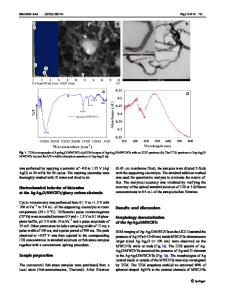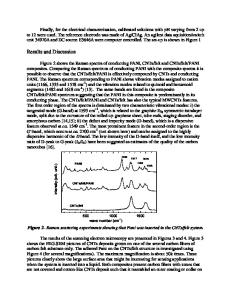Glassy Polymeric Carbon Resistivity as a Function of Carbon Nanotubes
- PDF / 495,565 Bytes
- 4 Pages / 612 x 792 pts (letter) Page_size
- 66 Downloads / 342 Views
1006-R07-13
Glassy Polymeric Carbon Resistivity as a Function of Carbon Nanotubes Bopha Chhay, Renato Minamisawa, Satilmis Budak, Bangke Zheng, and Daryush Ila Alabama A&M University, P.O. Box 1447, Normal, AL, 35762 ABSTRACT Glassy Polymeric Carbon (GPC) is a material widely used because of its high temperature properties, inertness and biocompatibility [1]. GPC samples were prepared from a phenolic resin, cured in a careful process at 100 ∫C and pyrolyzed to 1000 ∫C. In this work, we have introduced 3wt%, 10wt%, and 20 wt% of Carbon Nano Tubes (CNT) in the precursor resin to study the evolution of the electrical conductivities of the nanocomposite as a function of the CNT concentration. INTRODUCTION The glassy polymeric carbon ware was obtained by using a phenolic resin precursor (C7H8O) from Georgia Pacific. The production process consists of several slow and controlled heating stages where the material undergoes modification of its molecular structure, indicated by change of color and dimension. At 80-100 ∫C, the liquid precursor polymerizes and solidifies. On further heating, the material releases hydrogen and its long aromatic carbon chains are rearranged in a network of microfibrils forming a tighter mass, which enhances the electrical conductivity [2]. Recently, many CNT-related studies have been reported in several applications such as nano-electronics, nano-devices, etc [3]. CNT is a unique material that presents excellent mechanical, electrical and chemical properties. In this work, we dispersed CNT into the phenolic resin precursor to produce a GPC/CNT composite. We made three samples with three different concentrations of CNT: 3 wt%, 10 wt%, and 20 wt%. Our objective was to study the dependence of the electrical behavior of the new nano-composites as a function of the CNT added in the GPC matrix. EXPERIMENTAL PROCEDURES Three GPC composites thin film were prepared. We chose as dopant multi-walled CNTs. In a beaker, we put the CNT, then the ethyl alcohol (ethanol), and finally the phenolic resin, here called resol. The weight ratios of CNT to resol and ethanol to resol were 3:100 and 1:2, respectively. We thoroughly mixed the solution with a spatula to produce a homogeneous state. Meanwhile, an aluminum plate was maintained heated at 120 ∫C. We sprayed the solution that we prepared earlier onto the aluminum hot plate. By using the spraying technique, we deposited thin layers of solution. At this temperature, the liquid precursor polymerized and solidified while the solvent and moisture left the sample. When the film reached the desired thickness, we separated it from the aluminum plate. At this stage, the sample is cured [3]. The same procedure was followed for the preparation of 10 wt% CNT /GPC and 20 wt% CNT /GPC composite films.
With the three cured films, we proceeded with the sample preparation. We pyrolyzed them in argon from room temperature to1000 ∫C in 33 hours. Raman microprobe measurements were performed on the surface using a Labram spectrometer with a 632.8 nm red excitation from a Helium
Data Loading...











